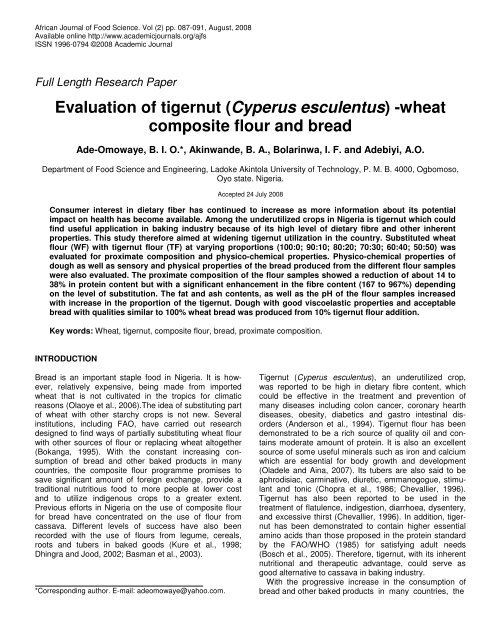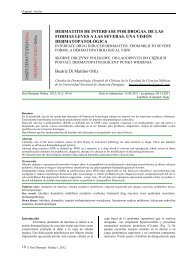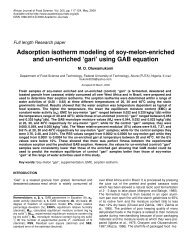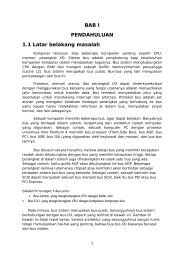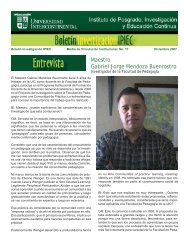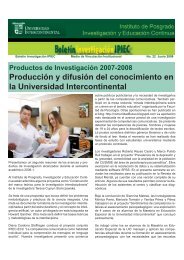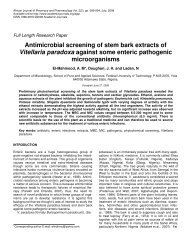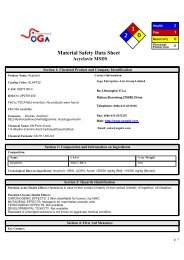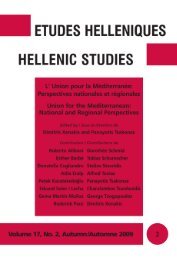wheat composite flour and bread - Science Stage
wheat composite flour and bread - Science Stage
wheat composite flour and bread - Science Stage
You also want an ePaper? Increase the reach of your titles
YUMPU automatically turns print PDFs into web optimized ePapers that Google loves.
African Journal of Food <strong>Science</strong>. Vol (2) pp. 087-091, August, 2008<br />
Available online http://www.academicjournals.org/ajfs<br />
ISSN 1996-0794 ©2008 Academic Journal<br />
Full Length Research Paper<br />
Evaluation of tigernut (Cyperus esculentus) -<strong>wheat</strong><br />
<strong>composite</strong> <strong>flour</strong> <strong>and</strong> <strong>bread</strong><br />
Ade-Omowaye, B. I. O.*, Akinw<strong>and</strong>e, B. A., Bolarinwa, I. F. <strong>and</strong> Adebiyi, A.O.<br />
Department of Food <strong>Science</strong> <strong>and</strong> Engineering, Ladoke Akintola University of Technology, P. M. B. 4000, Ogbomoso,<br />
Oyo state. Nigeria.<br />
Accepted 24 July 2008<br />
Consumer interest in dietary fiber has continued to increase as more information about its potential<br />
impact on health has become available. Among the underutilized crops in Nigeria is tigernut which could<br />
find useful application in baking industry because of its high level of dietary fibre <strong>and</strong> other inherent<br />
properties. This study therefore aimed at widening tigernut utilization in the country. Substituted <strong>wheat</strong><br />
<strong>flour</strong> (WF) with tigernut <strong>flour</strong> (TF) at varying proportions (100:0; 90:10; 80:20; 70:30; 60:40; 50:50) was<br />
evaluated for proximate composition <strong>and</strong> physico-chemical properties. Physico-chemical properties of<br />
dough as well as sensory <strong>and</strong> physical properties of the <strong>bread</strong> produced from the different <strong>flour</strong> samples<br />
were also evaluated. The proximate composition of the <strong>flour</strong> samples showed a reduction of about 14 to<br />
38% in protein content but with a significant enhancement in the fibre content (167 to 967%) depending<br />
on the level of substitution. The fat <strong>and</strong> ash contents, as well as the pH of the <strong>flour</strong> samples increased<br />
with increase in the proportion of the tigernut. Dough with good viscoelastic properties <strong>and</strong> acceptable<br />
<strong>bread</strong> with qualities similar to 100% <strong>wheat</strong> <strong>bread</strong> was produced from 10% tigernut <strong>flour</strong> addition.<br />
Key words: Wheat, tigernut, <strong>composite</strong> <strong>flour</strong>, <strong>bread</strong>, proximate composition.<br />
INTRODUCTION<br />
Bread is an important staple food in Nigeria. It is however,<br />
relatively expensive, being made from imported<br />
<strong>wheat</strong> that is not cultivated in the tropics for climatic<br />
reasons (Olaoye et al., 2006).The idea of substituting part<br />
of <strong>wheat</strong> with other starchy crops is not new. Several<br />
institutions, including FAO, have carried out research<br />
designed to find ways of partially substituting <strong>wheat</strong> <strong>flour</strong><br />
with other sources of <strong>flour</strong> or replacing <strong>wheat</strong> altogether<br />
(Bokanga, 1995). With the constant increasing consumption<br />
of <strong>bread</strong> <strong>and</strong> other baked products in many<br />
countries, the <strong>composite</strong> <strong>flour</strong> programme promises to<br />
save significant amount of foreign exchange, provide a<br />
traditional nutritious food to more people at lower cost<br />
<strong>and</strong> to utilize indigenous crops to a greater extent.<br />
Previous efforts in Nigeria on the use of <strong>composite</strong> <strong>flour</strong><br />
for <strong>bread</strong> have concentrated on the use of <strong>flour</strong> from<br />
cassava. Different levels of success have also been<br />
recorded with the use of <strong>flour</strong>s from legume, cereals,<br />
roots <strong>and</strong> tubers in baked goods (Kure et al., 1998;<br />
Dhingra <strong>and</strong> Jood, 2002; Basman et al., 2003).<br />
*Corresponding author. E-mail: adeomowaye@yahoo.com.<br />
Tigernut (Cyperus esculentus), an underutilized crop,<br />
was reported to be high in dietary fibre content, which<br />
could be effective in the treatment <strong>and</strong> prevention of<br />
many diseases including colon cancer, coronary hearth<br />
diseases, obesity, diabetics <strong>and</strong> gastro intestinal disorders<br />
(Anderson et al., 1994). Tigernut <strong>flour</strong> has been<br />
demonstrated to be a rich source of quality oil <strong>and</strong> contains<br />
moderate amount of protein. It is also an excellent<br />
source of some useful minerals such as iron <strong>and</strong> calcium<br />
which are essential for body growth <strong>and</strong> development<br />
(Oladele <strong>and</strong> Aina, 2007). Its tubers are also said to be<br />
aphrodisiac, carminative, diuretic, emmanogogue, stimulant<br />
<strong>and</strong> tonic (Chopra et al., 1986; Chevallier, 1996).<br />
Tigernut has also been reported to be used in the<br />
treatment of flatulence, indigestion, diarrhoea, dysentery,<br />
<strong>and</strong> excessive thirst (Chevallier, 1996). In addition, tigernut<br />
has been demonstrated to contain higher essential<br />
amino acids than those proposed in the protein st<strong>and</strong>ard<br />
by the FAO/WHO (1985) for satisfying adult needs<br />
(Bosch et al., 2005). Therefore, tigernut, with its inherent<br />
nutritional <strong>and</strong> therapeutic advantage, could serve as<br />
good alternative to cassava in baking industry.<br />
With the progressive increase in the consumption of<br />
<strong>bread</strong> <strong>and</strong> other baked products in many countries, the
88 Afr. J. Food Sci.<br />
Table 1. Proximate composition of the <strong>composite</strong> <strong>flour</strong> samples.<br />
Sample Moisture (%) Protein (%) Fat (%) Ash (%) Fibre (%) Carbohydrate(By Diff)<br />
A 14.7+0.1 c 15.1+0.3 f 1.3+0.3 a 0.45+0.01 a 0.3+0.1 a 68.7<br />
B 14.4+0.1 bc 12.9+0.5 de 4.6+0.2 b 0.8+0.02 b 0.8+0.1 ab 66.5<br />
C 14.4+0.0 bc 12.0+0.4 cd 7.7+0.3 c 1.1+0.02 c 1.4+0.4 bc 63.4<br />
D 14.2+0.0 b 11.1+0.3 bc 11.0+0.3 d 1.2+0.01 d 2.0+0.4 cd 60.5<br />
E 13.8+0.2 a 10.2+0.3 ab 14.0+0.2 e 1.4+0.01 e 2.6+0.3 de 58.0<br />
F 13.8+0.1 a 9.4+0.5 a 17.3+0.4 f 1.6+0.01 f 3.2+0.1 e 54.7<br />
Means followed by different superscript within a column are significantly different (p0.05)<br />
A-100%WF; B- 90%WF,10%TF; C- 80%WF,20%TF; D-70%WF,30%TF; E- 60%WF, 40%TF; F-50%WF, 50%TF<br />
<strong>composite</strong> <strong>flour</strong> programme, especially in developing<br />
countries, has the potential to conserve foreign exchange,<br />
provide nutritious food to more people at<br />
affordable cost <strong>and</strong> widen the utilization of indigeneous<br />
crops in food formulation.<br />
Information on the use of tigernut in baked goods is<br />
scanty. Thus, this study evaluated the proximate composition,<br />
physico-chemical <strong>and</strong> visco-elastic properties of<br />
<strong>flour</strong> <strong>and</strong> sensory properties of <strong>bread</strong> produced from<br />
<strong>wheat</strong>-tigernut <strong>composite</strong> <strong>flour</strong> at varying levels of<br />
tigernut substitution (10 - 50%).<br />
MATERIALS AND METHODS<br />
Dry tigernut (brown variety) was purchased locally. Wheat <strong>flour</strong> <strong>and</strong><br />
other principal ingredients like yeast, sugar, fat <strong>and</strong> salt were also<br />
obtained from a local market in the southwestern part of Nigeria.<br />
Preparation of tigernut <strong>flour</strong><br />
The method of Adeyemi (1988) was used in the preparation of<br />
tigernut <strong>flour</strong>. Dry tigernuts were sorted to remove unwanted<br />
materials like stones, pebbles <strong>and</strong> other foreign seeds, before<br />
washing with tap water. The cleaned nuts were dried in a cabinet<br />
dryer at 60 o C for 24 h to a moisture content of about 13%. The<br />
dried nuts were milled <strong>and</strong> sieved through 600 µm aperture size.<br />
The resultant <strong>flour</strong> was packed <strong>and</strong> sealed in polythene bags until<br />
analyzed.<br />
Preparation of the various <strong>flour</strong>s blends<br />
Flour blends containing varying proportions of tigernut <strong>flour</strong> (10 -<br />
50%) together with <strong>wheat</strong> <strong>flour</strong> were prepared by mixing required<br />
amounts of respective <strong>flour</strong>s.<br />
Production of <strong>bread</strong><br />
The procedure for the production of <strong>bread</strong> in AACC (1984) was<br />
used, which employs a bulk fermentation process. Two hundred<br />
gram of each of the <strong>composite</strong> <strong>flour</strong> sample was weighed along with<br />
the required amount of water to obtain dough, which was kneaded<br />
on a pastry-board to smoothen it. The dough was initially fermented<br />
for 2 h at 30 o C before being subsequently knocked back by kneading<br />
to expel carbon dioxide <strong>and</strong> tighten-up the dough to improve the<br />
texture of the final product. The secondary fermentation also lasted<br />
for 2 h at 30 o C. The dough were then sized<br />
<strong>and</strong> moulded into the baking pans for final proving at 30 o C for 2 h.<br />
Dough baking was carried out in the oven at a temperature of<br />
230 o C for 25 min.<br />
Proximate analysis<br />
Protein (N* 6.25), moisture, fat, ash <strong>and</strong> crude fibre contents were<br />
determined using AOAC (1990) methods. Carbohydrate content<br />
was determined by difference.<br />
Other analyses<br />
The pH <strong>and</strong> titratable acidity (TTA) of the <strong>composite</strong> <strong>flour</strong> were<br />
determined by the methods of AOAC (1990). Water absorption<br />
capacity (WAC) was determined using the method of Mbofung et al<br />
(2006). Bulk density was determined following the method describeed<br />
by Wang <strong>and</strong> Kinsella (1976). The visco-elastic property of<br />
dough from the <strong>composite</strong> <strong>flour</strong> was determined using alveograph<br />
mixer as described by Gilles <strong>and</strong> Medcalf (1965).<br />
Sensory evaluation<br />
The baked, cooled <strong>bread</strong> samples were presented to 10 semi -<br />
trained panelists using the method described by Taiwo et al. (1997).<br />
The panelists were asked to indicate their observations using a 6<br />
point hedonic scale for crust colour, crumb colour, crumb grain<br />
texture, aroma, taste, flavour, symmetry, <strong>and</strong> overall acceptability.<br />
Excellent <strong>and</strong> very poor were ranked 6 <strong>and</strong> 1 respectively.<br />
Statistical analysis<br />
All analyses were carried out in duplicates <strong>and</strong> the data collected<br />
were analyzed using Plot IT software (SPE, 1993). Data were<br />
subjected to analysis of variance (ANOVA) <strong>and</strong> Turkey’s test was<br />
used for comparison of means. Significance was accepted at p =<br />
0.05.<br />
RESULTS AND DISCUSSION<br />
Proximate composition<br />
Proximate composition of the <strong>flour</strong> samples are presented<br />
in Table 1. The protein content (%) of the <strong>composite</strong><br />
<strong>flour</strong> decreased from 12.9 to 9.40 with increase in tigernut<br />
<strong>flour</strong> substitution. This may be attributed to low protein<br />
content of tigernut (Addy <strong>and</strong> Eteshola, 1984). Although<br />
there was a reduction in the protein content of substituted
Ade-Omowaye et al. 089<br />
Table 2. Physico-chemical properties of the <strong>flour</strong> samples.<br />
Sample Titratable acidity (%) pH Water absorption capacity (%) Bulk density (g/ml)<br />
A 0.057 e 5.80 a 85.17 a 0.57 a<br />
B 0.054 e 5.95 b 85.36 ab 0.59 ab<br />
C 0.045 d 6.02 bc 85.5.0 b 0.60 bc<br />
D 0.041 c 6.06 bcd 85.61 bc 0.61 bc<br />
E 0.036 b 6.10 cd 85.85 cd 0.62 cd<br />
F 0.024 a 6.16 d 86.01 d 0.64 d<br />
Means followed by different superscript within a column are significantly different (p0.05)<br />
A, B, C, D, E, <strong>and</strong> F are as defined in Table 1<br />
Table 3. Visco-elasticity properties of dough from <strong>wheat</strong>-tiger<br />
nut <strong>flour</strong> mixes.<br />
Samples P (mmHg) L (mm) G W (J)<br />
A 130 e 79 e 19.8 e 402 f<br />
B 106 d 63 d 17.7 d 276 e<br />
C 90 c 52 c 16.1 c 190 d<br />
D 76 b 42 b 14.4 b 134 c<br />
E 62 a 38 b 13.7 b 100 b<br />
F 58 a 22 a 10.5 a 60 a<br />
P- Resistance to deformation of the dough; L- Dough extensibility;<br />
G- Index of swelling; W-Deformation work. Means followed by<br />
different superscript within a column are significantly different<br />
(p0.05)<br />
A, B, C, D, E, <strong>and</strong> F are as defined in Table 1<br />
<strong>wheat</strong> <strong>flour</strong> samples with tigernut <strong>flour</strong>, a notable<br />
enhancement of fiber content in the range of 167 - 967%<br />
was achieved. Tigernut addition also resulted in 71 to<br />
256% improvement in the ash content of the <strong>composite</strong><br />
<strong>flour</strong>. The fat content (%) of the <strong>composite</strong> <strong>flour</strong> increased<br />
from 1.3 to 17.3 proportionately as tigernut <strong>flour</strong> increaseed.<br />
This might be due to high fat content (32.88%) of the<br />
tigernut <strong>flour</strong> (Addy <strong>and</strong> Eteshola, 1984). Hence, defatting<br />
the nut before utilization may yield better result. The<br />
carbohydrate content (%) of the <strong>composite</strong> <strong>flour</strong> decreased<br />
from 68.7 to 54.7% indicating low carbohydrate<br />
content of the tigernut <strong>flour</strong>.<br />
Physico-chemical properties of the <strong>flour</strong><br />
Water absorption capacity (WAC) of the <strong>composite</strong> <strong>flour</strong><br />
ranged from 85.17 to 86.01% as indicated in Table 2. The<br />
rate at which each sample absorbed water increased with<br />
increase in tigernut addition. No significant difference was<br />
found between pure <strong>wheat</strong> <strong>flour</strong> <strong>and</strong> substituted <strong>wheat</strong><br />
<strong>flour</strong> with 10% tigernut <strong>flour</strong>. However there were significant<br />
differences among 100% <strong>wheat</strong> <strong>flour</strong> <strong>and</strong> other<br />
substituted <strong>wheat</strong> <strong>flour</strong> samples. Alobo <strong>and</strong> Ogbogo<br />
(2007) reported that the WAC of gelatinized tigernut<br />
starch was 70%. The increase in WAC of the <strong>composite</strong><br />
<strong>flour</strong> may be attributed to higher fibre <strong>and</strong> starch contents<br />
with increasing tigernut substitution. The ability of <strong>flour</strong> to<br />
absorb water was reported to have a significant correlation<br />
with its starch content (Mbofung et al., 2006).<br />
Result of the bulk density of the samples is also<br />
presented in Table1. The values ranged from 0.57 to 0.64<br />
g/ml which showed an increasing trend with increase in<br />
tigernut <strong>flour</strong> addition. Earlier work has reported bulk<br />
density of 0.48 - 0.66 g/ml for raw <strong>and</strong> malted <strong>wheat</strong> <strong>flour</strong><br />
(Magnesia <strong>and</strong> Wafflemix, 2007), which is comparable to<br />
that obtained in this study. There was increase in pH<br />
values with corresponding decrease in titratable acidity<br />
values of the <strong>flour</strong> samples as the content of tigernut <strong>flour</strong><br />
increased (Table 2). The titratable acidity values ranged<br />
from 0.024 to 0.057% while the pH values were between<br />
5.80 <strong>and</strong> 6.16. An earlier report has shown that the pH of<br />
cassava <strong>flour</strong> was 6.55 (Chinma <strong>and</strong> Ocheme, 2007).<br />
Visco-elastic properties of dough from the <strong>flour</strong><br />
samples <strong>and</strong> physical characteristic of <strong>bread</strong><br />
Result of the visco-elastic characteristics of the dough is<br />
presented in Table 3. The index of swelling of the dough<br />
ranged from 10.5 to 19.8 with the dough from pure <strong>wheat</strong><br />
<strong>flour</strong> having the highest value <strong>and</strong> the sample substituted<br />
with the highest level of tigernut had the least value. A<br />
decreasing trend (60 - 402 J) in the deformation work<br />
was observed with increase in the level of tigernut addition.<br />
The extensibility of the dough ranged from 22 to 79<br />
mm while the dough resistance to deformation ranged<br />
between 58 <strong>and</strong> 130 mmHg. Pure <strong>wheat</strong> dough had the<br />
highest values in all the parameters evaluated. Wheat<br />
produces white <strong>flour</strong> that has a unique property of <strong>wheat</strong><br />
proteins, which can produce dough with sufficient<br />
strength <strong>and</strong> elasticity required to produce low density<br />
<strong>bread</strong>. This observation suggests that an increase in<br />
tigernut <strong>flour</strong> addition result in reduced dough extensibility.<br />
The high fat <strong>and</strong> fibre contents in tigernut may be<br />
responsible for the reduction in the dough elasticity of the<br />
substituted <strong>wheat</strong> <strong>flour</strong> with tigernut <strong>flour</strong>. However, the<br />
visco-elastic property of dough produced from <strong>flour</strong> substituted<br />
with 10% tigernut <strong>flour</strong> was close to that of pure<br />
<strong>wheat</strong> <strong>flour</strong>, suggesting its potential utilization in the<br />
baking sector.<br />
The loaf volume ranged from 145 to 350 cm 3 as shown
090 Afr. J. Food Sci.<br />
Table 5. Scores for sensory attributes of <strong>bread</strong> samples from the <strong>composite</strong> <strong>flour</strong>.<br />
Sample code<br />
Attributes<br />
Crust<br />
colour<br />
Crumb<br />
colour<br />
Crumb grain<br />
texture<br />
Quality attributes<br />
Symmetry Taste Aroma Overall<br />
acceptability<br />
A 5.3 a 5.3 a 5.4 a 5.8 a 4.7 a 4.3 b 5.8 a<br />
B 5. 3a 5.2 a 5.3 a 5.6 a 4.8 a 4.6 a 5.6 a<br />
C 4.4 b 4.3 b 4.8 b 5.4 a 5.3 a 5. 0a 5.5 a<br />
D 4.0 b 4.0 b 4.1 c 4.7 b 4.9 a 5.0 a 4.9 b<br />
E 3.6 b 3.6 b 3.5 c 4.3 b 4.8 a 5.0 a 4.6 b<br />
F 2.8 c 3.0 c 3.0 c 3.4 c 5.1 a 5.2 a 3.4 c<br />
Means followed by different superscript within a column are significantly different (p0.05)<br />
A, B, C, D, E, <strong>and</strong> F are as defined in Table 1.<br />
Table 4. Loaf volume (100 g dough) of <strong>bread</strong><br />
produced from the <strong>composite</strong> <strong>flour</strong> samples.<br />
Samples Volume (cm 3 )<br />
A<br />
350 f<br />
B<br />
315 e<br />
C<br />
290 d<br />
D<br />
240 c<br />
E<br />
175 b<br />
F<br />
145 a<br />
Means followed by different superscript within a<br />
column are significantly different (p0.05) A, B,<br />
C, D, E, <strong>and</strong> F are as defined in Table 1.<br />
in Table 4, with 100% <strong>wheat</strong> <strong>bread</strong> having the highest<br />
value. This result showed reduced loaf volume as proportion<br />
of tigernut increased in the <strong>flour</strong> mixes. However,<br />
volume of <strong>bread</strong> produced from 90:10 <strong>wheat</strong>- tigernut<br />
mixes was comparable to those produced from pure<br />
<strong>wheat</strong> <strong>flour</strong>.<br />
Sensory properties<br />
The mean sensory scores for the <strong>bread</strong> produced from<br />
the <strong>composite</strong> <strong>flour</strong> are presented in Table 5. The result<br />
of the sensory evaluation revealed that <strong>bread</strong> from pure<br />
<strong>wheat</strong> <strong>flour</strong> <strong>and</strong> those produced from <strong>composite</strong> <strong>flour</strong> with<br />
10% <strong>and</strong> 20% tigernut <strong>flour</strong> were rated alike in almost all<br />
the quality attributes evaluated indicating the feasibility of<br />
adding tigernut to baked goods. This result suggests the<br />
potential application of tigernut <strong>flour</strong> either as full fat or<br />
defatted <strong>flour</strong> in baking industry.<br />
Conclusion<br />
Inclusion of tigernut <strong>flour</strong> in <strong>wheat</strong> <strong>flour</strong> at levels of 10 to<br />
50% resulted in notable increase in fibre <strong>and</strong> ash contents<br />
while protein content decreased. The significant<br />
increase in the fibre content (167 to 967%) could be<br />
nutritionally advantageous in Nigeria, where white <strong>bread</strong><br />
is one of commonest staples among all classes of people.<br />
Evaluation of the viscoelastic properties of dough<br />
from the <strong>composite</strong> <strong>flour</strong>, physical <strong>and</strong> sensory properties<br />
of <strong>bread</strong> revealed that a 10% <strong>wheat</strong> <strong>flour</strong> substitution with<br />
tigernut <strong>flour</strong> yielded <strong>bread</strong> product that was similarly<br />
rated with that produced from pure <strong>wheat</strong> <strong>flour</strong>. From the<br />
result of this study, it could be suggested that tigernut<br />
<strong>flour</strong> might find useful application in the Nigerian baking<br />
industry.<br />
REFERENCES<br />
AACC (1984). Approved methods of analysis. St. Paul. Minnesota: The<br />
American Association of Cereal Chemists p.1298<br />
AOAC (1990). Association of Official Analytical Chemists, 15 th Edition.<br />
Wincosin U.S.A. p. 1298<br />
Adeyemi IA (1988). A research Note: Ogi quality sorghum dry milled<br />
from fermented Sorghum Grains. J. Cereal Sci. 53: 640-642.<br />
Addy EO, Eteshola E (1984). Nutritive value of a mixture of Tigernut<br />
tubers <strong>and</strong> baobab seeds. J. <strong>Science</strong>, Food Agric. 35: 437-440.<br />
Anderson JW, Smith BM, Gustafson NJ (1994). Health benefits <strong>and</strong><br />
practical aspects of high fibre diets. Ame. J. Clinical Nutr. 59:<br />
1242S-1247S.<br />
Alobo AP, Ogbogo PO (2007). Selected properties of tigernut starch as<br />
affected by physical <strong>and</strong> chemical modifications. Proceeding of the<br />
31 st annual NIFST conference, Abuja, Nigeria. 22 nd – 25 th October,<br />
2007.<br />
Basman A, Koksel H (2003). Utilization of transgluranase use to<br />
increase the level of barley <strong>and</strong> soy <strong>flour</strong> incorporation in <strong>wheat</strong> <strong>flour</strong><br />
<strong>bread</strong>s. J. Food Sci. 68(8): 2453-2460.<br />
Bokanga M (1995.) Cassava: Opportunity for food, feed, <strong>and</strong> other<br />
industries in Africa. In: Agbor T, Egbe A, Brauman Griffon D, Treche<br />
S (eds.) Orstom. pp. 557-569.<br />
Bosch L, Alegria A, Farre R (2005). RP-HPLC Determination of tigernut<br />
<strong>and</strong> Orgeat amino acid contents. Food Sci.Technology Inter. 11(1):<br />
33-40.<br />
FAO/WHO (1985). Energy <strong>and</strong> Protein requirement, Geneva. Report of<br />
a joint FAO/WHO/UNU expert consultation. WHO Technical report<br />
Series No. 724.<br />
Chevallier A (1996). The Encyclopedia of medicinal plants. Dorling<br />
Kindersley. London. ISBN. 9: 980751-303148.<br />
Chinma CE, Ocheme OB (2007). Effect of simple wetting method for<br />
cyanide reduction on the physico-chemical properties of cassava<br />
<strong>flour</strong>. Proceeding of the 31 st annual NIFST conference, Abuja, Nigeria.<br />
22 nd – 25 th October, 2007.<br />
Chopra RN, Nayar SL, Chopra IC (1986). Glossary of Indian medicinal<br />
plants (Including the supplement). Council of scientific <strong>and</strong> industrial<br />
research, New Delhi. pp. 18-30.<br />
Dhingra S, Jood S (2002). Physico-chemical <strong>and</strong> nutritional properties
Ade-Omowaye et al. 091<br />
of cereal-pulse blends for <strong>bread</strong> making. Nutrition <strong>and</strong> Health. 16(3):<br />
183-94.<br />
Gilles KA <strong>and</strong> Medcalf DG (1965). Wheat starches, comparison of<br />
physicochemical properties. Cereal Chemistry 42: 558-685<br />
Kure OA, Bahago EJ, Daniel EA (1998). Studies on the proximta<br />
composition <strong>and</strong> effect of <strong>flour</strong> particle size of acceptability of biscuits<br />
produced from blends of soybeans <strong>and</strong> plantain <strong>flour</strong>s. J. Namoda<br />
Technol. 3(2): 17-22.<br />
Magnesia M., Wafflemix W.S.(2007). Engineering resources Bulk<br />
density & specific gravity chart. Camber Southeast. Inc.<br />
(www.powder<strong>and</strong>bulk.com/resources/material_bulk_density_charts.ht<br />
m)<br />
Mbofung CMF, Abuobakar YN, Njintang A, Abduo Boubak, Balaam F<br />
(2006). Physico-chemical <strong>and</strong> functional properties of six varietes of<br />
Taro (Colocasia esculenta L.schott) <strong>flour</strong>. J. Food Technol. 4(2): 135-<br />
142.<br />
Oladele AK, K Aina JO (2007). Chemical composition <strong>and</strong> functional<br />
properties of <strong>flour</strong> from two varieties of tigernut (Cyperus esculentus).<br />
Afr. J. Biotechnol. 6(21): 2473-2476.<br />
Olaoye OA, Onilude AA, Idowu OA (2006). Quality characteristics of<br />
<strong>bread</strong> produced from <strong>composite</strong> <strong>flour</strong>s of <strong>wheat</strong>, plantain <strong>and</strong><br />
soybeans. Afr. J. Biotechnol. 5 (11): 1102-1106.<br />
SPE (1993). Scientific Program Enterprises. Computer software PlotIT<br />
Graphics <strong>and</strong> statistics version 2.0 (ICS GmbH, Frankfurt).<br />
Taiwo, K.A., Akanbi, C.T., Ajibola, O.O. (1997). Establishing processing<br />
conditions for canning cowpea seeds in tomato sauce. Inter. J.Food<br />
Sci. Technol. 32: 313-324.<br />
Wang YD, Kinsella JE (1976). Functional properties of Novel Protein.<br />
J.Food Sci. 41(2): 286-294.


